Given Croatia has four wine regions: Istria and Kvarner, Dalmatia, Slavonia and Danube, and Upland Croatia, we decided to centered our wine adventure on South Dalmatia's Pelješac Peninsula. Besides the Pelješac peninsula's natural beauty, it is home to olive groves and vineyards. Pelješac Peninsula wine country is known for its Dingač and Postup appellations. It is a paradise for oenophiles, a region renowned for its robust red wine, Plavac Mali. Our Pelješac Peninsula wine journey took us to charming family-owned vineyards at Matuško Winery, Miloš Winery, Grgic Winery, and Saints Hills Winery.
Before I share an overview of our wine journey let's take a look at the Dingač and Postup appellations, both of which are known for their Plavac Mali and other wines.
Welcome to Dingač and Postup Appellations
Plavac Mali, the best known Croatian wine, the nation's most sought-after red wine, is one of Croatia's most planted varieties. It was the first Croatian grape to have its own appellation, Dingač. The Dingač Appellation on Dalmatia's Pelješac Peninsula was established in 1961. Plavac Mali thrives here where it receives lots of sunshine, heat, and minimal rain during the late spring and summer. Wines bearing the Dingač name come from the southwest facing slopes on the steep coastline.
Driving through this appellation catches immediate attention.
The Dingač appellation was established in 1961. Plavac Mali, Croatia's most widely planted red grape, thrives here. Wines bearing the Dingac name come from the southwest facing slopes on the steep coastline between the small villages of Trstenik and Podobuce. Dingac was Croatia’s first appellation, and continues to showcase Croatian Plavac Mali wine today. Dingač (615 hectares/1520 acres) on the southern side of the Pelješac peninsula is a wine-producing area with a Protected Geographical Indication (PGI). The vineyards unique characteristics are due to their specific Mediterranean climate, soil quality, and steep inclination with southern exposure.
Dingač wine is protected by the Dingač Appellation of Origin, which guarantees that strict regulations regarding grape selection, winemaking processes, and aging requirements produce the wine. The wine is typically aged in oak barrels, contributing to its complexity and depth of flavor and softening the tannins. Dingač, continues to showcase Croatian Plavac Mali wine today.
A little west of Dingac, overlooking the bay of Orebic and the island of Korubuc beyond, are the vineyards of the Postup Appellation. Postup Appellation was the second Croatian wine region, after Dingač, to be registered for state protection in 1967. Located just to the east of Orebić. It takes its name from the small village that sits at the center of it. Postup straddles the Adriatic Sea with views across the Pelješac Channel to the islands of Korčula and Badija, and as well across the Mljet Channel to the islands of Mljet and Lastovo. The main grape harvested in Postup is Plavac Mali. Like the grapes from the nearby Dingač, the grapes grown here are held in high regard.
Postup Plavac Mali wines, are not quite as full-bodied or complex as those of Dingac however, they are notably richer than those produced on the mainland. While they do not approach the robust character of Plavac Mali-based wines from Dingač, they still develop a fuller body than those grown in the interior. This is due to the slope of the vineyards, and as well as the sunlight reflected from the Adriatic Sea. The grapes are also considerably easier to harvest than those of Dingač due to a more established infrastructure.
The Postup and Dingač Appellations are the best-known examples of Plavac Mali wines. It is the most extreme conditions in which the Plavac Mali variety is cultivated. As a result, a job that would require an hour’s work from a winemaker at a conventional vineyard demands three hours on Dingač and Postup. Dingač and the neighboring Postup area are considered the most extreme conditions in which Plavac Mali can be cultivated. The vines experience what is known as triple insolation, with the vineyards being exposed to three sources of intense sun namely: (1) direct sun rays are intensified by the dry and rain-deficient location;(2) reflected sun rays from the sea are very intense given the vineyard is tilted at 45 degrees; and (3) sun reflections from the white rock surfaces are reflected from below the vine.
Some Pelješac Peninsula wineries also produce Plavac Mali from grapes grown in the Komarna wine region, Croatia's youngest appellation. Komarna is located between the historic cities of Split and Dubrovnik. It is the first entirely ecologically certified region in the country. While its Plavac Mali is different, the wine is elegant with pronounced red fruit notes, more mature tannins, and less jam and plum notes. Overall the wine is not as concentrated and powerful as the renowned Dingač and Postup appellations. After visiting the Pelješac Peninsula's Dingač and Postup Appellations we also visited Rizman Winery in the Kormarna wine region. Valentina Silovic, Wine & More provides a comprehensive Plavac Mali overview of this wine from the different wine areas.
Off on a Pelješac Peninsula Wine Adventure
For sure the Pelješac Peninsula's inspiring landscape, pristine beaches, crystal-clear turquoise waters, and rugged cliffs attracts outdoor enthusiasts. There is lots to explore along, its coastline's hidden coves and bays, hiking trails, and of course olive groves and vineyards. For me there is no substitute for researching and experiencing where the wines where they are produced. Join me as I share Plavac Mali and other wines from the Pelješac Peninsula's Dingač and Postup.
After we were picked up in historic center of Dubrovnik and driven to Ston. Ston has a rich history with its stone walls, and salt production. Besides it fascinating history these days Ston is know as an idyllic Adriatic oyster village. Many come to Ston to enjoy oysters.
1. Miloš Winery, Ponikva
Miloš Winery was the beginning of our wine adventure through the charming Pelješac Peninsula family-owned vineyards.
YES, that was the day I discovered Miloš Stagnum, the first Croatian cult wine. After visiting Miloš Winery our spring time travels continued through charming family-owned Pelješac Peninsula vineyards.
2. Saints Hills, Oskorušno
Saints Hills Winery, Oskorušno is a boutique family winery, built on the site of an old stone house, is the perfect place to kick-off a Croatian wine journey.
We were indeed excited that our wine country explorations took us to Saints Hills Winery.
Saints Hills Winery, Pelješac Peninsula, Croatia
Welcome to Croatia's Wines of the Saints
Upon arrival we toured the winery (vinaria) and enjoyed learning about its operations. The staff at Saints Hills Winery went over and beyond in welcoming us on that cool April day.
Saints Hills Winery was founded in 2006. This family winery's dream is to present Croatian wines that are made in a modern way, and respectful of nature. Their children (Lucia, Roko and Ante), as are each of their vineyards (St. Lucia, St. Roch and St. Anthony), and olive orchard, are named after a saint. Hence Saints Hills wines can be appropriately referred to as Wines of the Saints. Moreover, to ensure the production of quality wines, Michel Rolland, a family friend and world renown oenologist, is a consultant with the winery.
We began our winery tour in the tank room. Here we learnt about the various fermentation processes.
Their cellar, where the special wine bottles are stored, is quite stunning. Seeing the Treasury Room on their website is no substitute for being there.
Throughout the property there were signs of ongoing spring activities. I loved seeing the flower boxes.
Perhaps few insights into the Pelješac Peninsula Saints Hills wines should be made with Dingač and Postup appellations where its Plavac Mali grapes are grown. Saints Hills also produces Plavac Mali from grapes grown in the Komarna wine region, Croatia's youngest appellation. Komarna is located between the historic cities of Split and Dubrovnik. It is the first entirely ecologically certified region in the country. While its Plavac Mali is different, elegant with pronounced red fruit notes, more mature tannins, and less jam and plum notes, but not concentrated and powerful as those from renowned Dingač and Postup appellations. Valentina Silovic, Wine & More provides a comprehensive Plavac Mali overview of the different wine areas.
Winery visitors can enjoy a wine tasting on one of their patio areas. The terrace patio overlooking the vineyard is perhaps the favorite.
At Saints Hills restaurant we had the privilege of pairing a gourmet dinner with their wines during our visit. Thanks to our host Josefina Muscianisi Soldati, and to Chef Ivana Bjeliš. Josefina, has extensive experience in the wine industry. For me this experience was a lovely way to appreciate the property while learning about Croatian wine. We tasted some exceptional bottles of wine while we enjoyed a Michelin-worthy meal. During my wine travels I have experienced no shortage of great restaurants; so I know what it means to taste food that is made with love. It was a meal to remember and Chef Ivana created vegetarian version of her menu in addition to the regular version. Dishes tend to follow traditional Dalmatian recipes with a little twist from the chef who prepares food made with love. All ingredients are fresh and local, and vegetables and spices are grown in their garden. From beginning to end, we enjoyed every single bite. This is a chief is driven by passion and who cooks because she loves it so much.
When I think about our experience at Saints Hills, I recall how generous they were to us. We will always remember our Saints Hills experience.
Given Saints Hills produces Croatian wines outside Pelješac region we were able to explore these as well. Saints Hills has vineyards in Istria and Komarna. We began our wine tasting with an Istria Sauvignon Semillion blend.
This is a most delightful Plavac Mali rosé wine.
3. Matuško Winery, Potomje
Grape growing and wine making has long been a Matuško family tradition, which in 1997 led to the founding of their family winery in Potomje. I was delighted that our spring time journey took us to this charming family-owned winery.
While at the winery I did manage to take a picture of early springtime in the vineyard.
While in Potomje we also explored the Dingač appellation.
Matuško Winery is well known for producing high quality wines from the Pelješac Peninsula and the wider Dubrovnik Neretva County native grapes.During our Matuško Winery visit the hostess took us on a brief tour, including the 3,000m2 wine cellar. We were given an overview of the wine making process and some of the winery's history. After the tour we returned to the tasting room.
The wine tasting began with the white wines Pošip and Grk.
We began with Matuško Pošip.
Matuško Winery, Pošip Primorska Hrvatska 2024
Pošip, Matuško Winery © Spaswinefood
This was my first time tasting Grk wine. Grk Bijeli or Grk, a white grape variety found on Croatia's Korčula island. Since Grk has only female flowers it must be co-planted with another grape variety that has male flowers in order to pollinate. It is most commonly planted with Plavac Mali.
While tasting the wines I loved seeing the Matuško wine display.
Next, their Plavac Mali wines were introduced. They are known for their Plavac Mali wines, with the grapes coming from Pelješac Peninsula's Dingač and Postup appellations.
Matuško produces a variety of Plavac Mali wines. We tasted their 2016 Reserva.
Matuško Winery, Dingač Reserva Barrique 2016
Matuško Winery also produces Prošek, a dessert wine that is traditionally made in South Dalmatia. It is made using dried wine grapes in the passito method. The indigenous white grape variety Rukatac is used to make this Prošek. Maraština is often the name used for (Rukatac, Maraškin, Mareština, Krizol, Višana) however, Rukatac is the commonly used name on the Dalmatian coast.
We absolutely loved discovering Matuško wines. If you get the opportunity to taste these wines do not pass it up. These are great wines. Besides Matuško growing into a successful winery over the years they are also home to an olive oil mill. Special thanks to winery staff at Matuško Winery for being such a delight.
4. Grgić Vina, Trstenik
Croatia's Grgić Vina was an absolute must for me when my wine travels took me to the Peljesac Peninsula. Grgić Vina (winery) was founded in 1996 by Croatian-born Miljenko “Mike” Grgich, his daughter, Violet Grgić and his nephew, Ivo Jeramaz. Long before founding Grgić Vina, Grgich, a renowned winemaker had already established a global reputation. Grgich, was the genius behind California's Chateau Montelena Chardonnay, which triumphed over its esteemed French competitors at the Judgement of Paris in 1976. He then founded Napa Valley's Grgich Hills Estate, and would continue to make significant contributions to the American wine industry.
Mike Grgich (April 1, 1923 – December 13, 2023) Croatian-American winemaker was recognized for his contributions to the American wine industry, by being inducted into the Culinary Institute of America's Vintner's Hall of Fame on March 7, 2008. This tribute was made when Grgich celebrated his 50th vintage of winemaking in the Napa Valley. Knowing of Grgich's lifetime contributions to the wine world, and his Croatian roots I was excited to visit Grgić Vina.
Peljesac Peninsula's Grgić Vina is a part of Croatia's wine history. Once the Croatian War of Independence (1991-1995) ended Mike returned to Croatia and established a winery. Toether with his daughter, Violet Grgić and his nephew Ivo Jeramaz, Grgić Vina was founded in 1996. In conjunction with this effort he also introduced modern winemaking techniques to the challenging slopes of Pelješac.
Welcome to Grgić Vina, Trstenik
Knowing the above story, I just had to visit Grgić Vina. We were most fortunate to have a wonderful hostess who took us on a brief winery tour, then walked us through the wine tasting. We also learnt about some of the winery's history, and her family's involvement in the winemaking process at Grgić Vina.
Given Mike's dedication to the art of winemaking, when he started a winery in Croatia he decided to produce the finest wines from the best known native Dalmatian grapes, Plavac Mali (red wine), and Pošip (white wine). We were fortunate to taste both of the wines at the winery.
1. Grgić Vina, Pošip Croatia 2023
For sure the sea view through the window was beautiful.

Our hostess next introduced the winery's most celebrated wine, their esteemed Plavac Mali.
Earlier she explained that Plavac Mali undergoes a meticulous two-year process to achieve perfectly harmonized flavors.This process includes a remarkable 15 months of aging in French oak barrels.
2. Grgić Vina, Plavac Mali Croatia 2021
During our brief tour I managed to capture a photo some Grgić Vina bottles, I even spotted a Grgich Hills Estate Rosé amongst the bottles.
At Grgić Winery, visitors can enjoy wine tastings and tour the winery to explore their winemaking process. For sure it was important to learn about the history and philosophy behind this winery.
Entrance Grgić Vina © Spaswinefood
The picturesque surroundings of Trstenik, with its vineyards and coastal beauty, made our visit even more enjoyable.
The Californian-Croatian Connection
Indeed, Mike Grgich was the winemaker of the iconic Chateau Montelena Chardonnay. Yes, the Chardonnay that upset French wine critics in the 1976 Paris Judgement. Grgich later founded his own Napa Valley winery, Grgich Hills Estate. Throughout his long career he would continue to make significance contributions.
Although Grgich, received countless gold medals and many accolades for his California-made-wines, some claim the most meaningful awards to him, were the ones he received for his Croatian Pošip and Plavac Mali wines. All wines made in at Grgić Vina have been judged to be top premium wines.
Grgić Vina is a special place in the world of wine. Thanks Grgić Vina for the visit.
Bye for Now








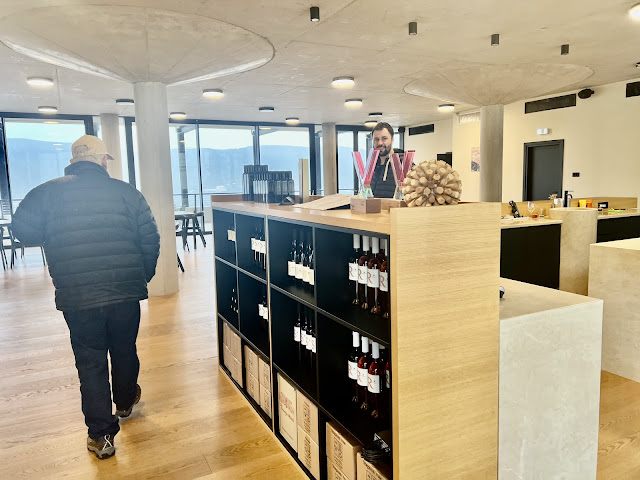





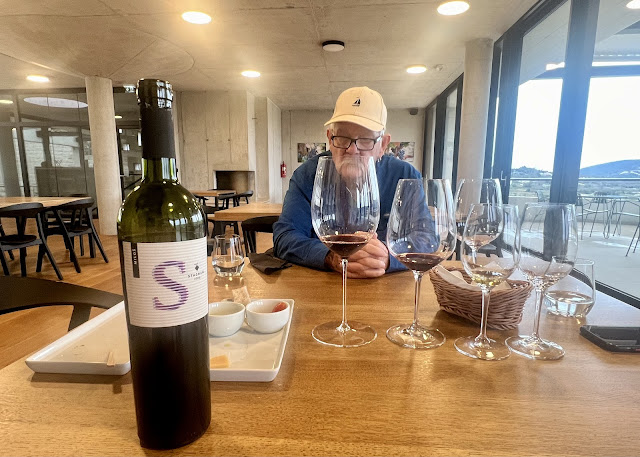






























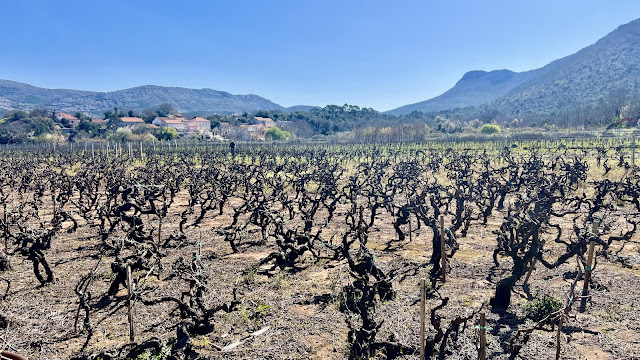










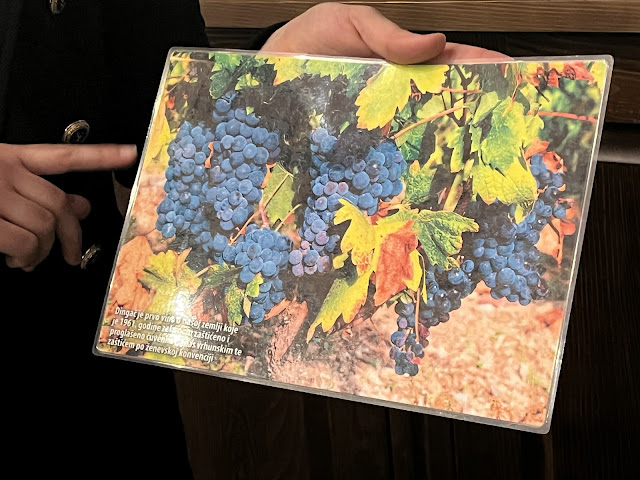
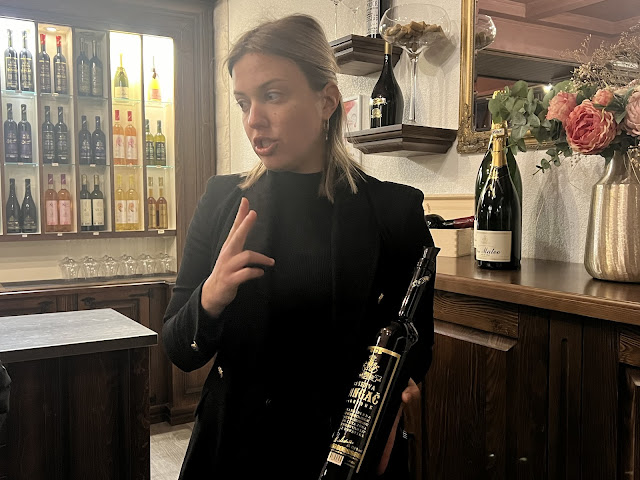










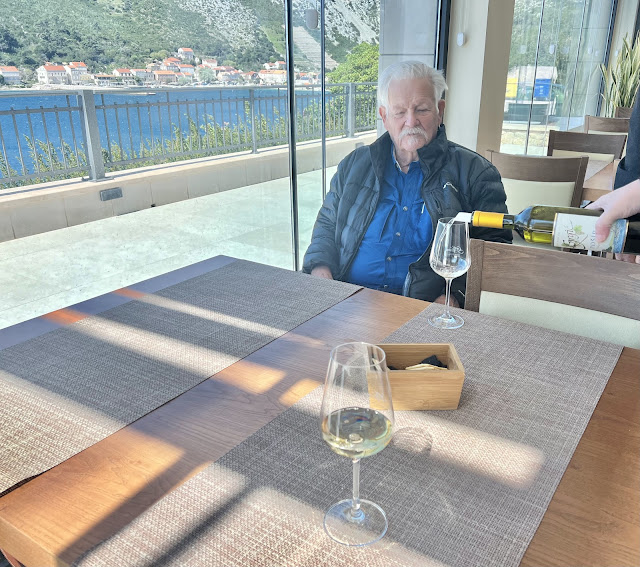













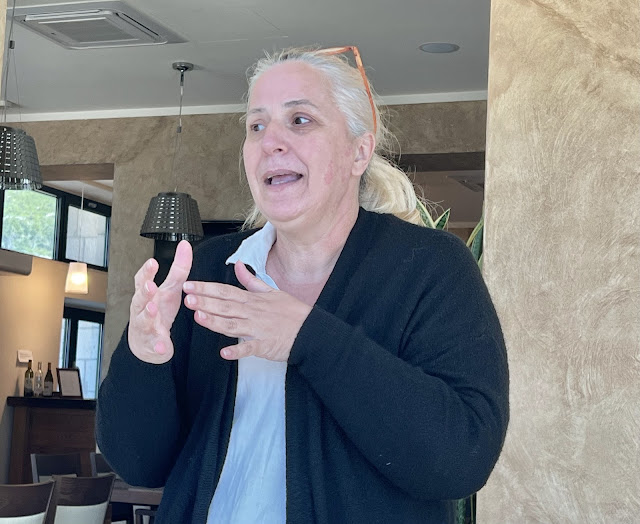
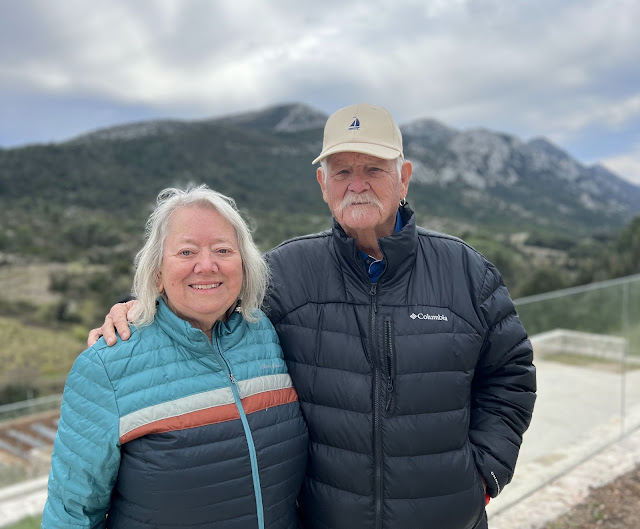




No comments:
Post a Comment